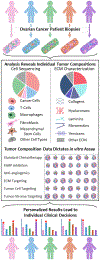Personalized models of heterogeneous 3D epithelial tumor microenvironments: Ovarian cancer as a model
- PMID: 33940195
- PMCID: PMC8969826
- DOI: 10.1016/j.actbio.2021.04.041
Personalized models of heterogeneous 3D epithelial tumor microenvironments: Ovarian cancer as a model
Abstract
Intractable human diseases such as cancers, are context dependent, unique to both the individual patient and to the specific tumor microenvironment. However, conventional cancer treatments are often nonspecific, targeting global similarities rather than unique drivers. This limits treatment efficacy across heterogeneous patient populations and even at different tumor locations within the same patient. Ultimately, this poor efficacy can lead to adverse clinical outcomes and the development of treatment-resistant relapse. To prevent this and improve outcomes, it is necessary to be selective when choosing a patient's optimal adjuvant treatment. In this review, we posit the use of personalized, tumor-specific models (TSM) as tools to achieve this remarkable feat. First, using ovarian cancer as a model disease, we outline the heterogeneity and complexity of both the cellular and extracellular components in the tumor microenvironment. Then we examine the advantages and disadvantages of contemporary cancer models and the rationale for personalized TSM. We discuss how to generate precision 3D models through careful and detailed analysis of patient biopsies. Finally, we provide clinically relevant applications of these versatile personalized cancer models to highlight their potential impact. These models are ideal for a myriad of fundamental cancer biology and translational studies. Importantly, these approaches can be extended to other carcinomas, facilitating the discovery of new therapeutics that more effectively target the unique aspects of each individual patient's TME. STATEMENT OF SIGNIFICANCE: In this article, we have presented the case for the application of biomaterials in developing personalized models of complex diseases such as cancers. TSM could bring about breakthroughs in the promise of precision medicine. The critical components of the diverse tumor microenvironments, that lead to treatment failures, include cellular- and extracellular matrix- heterogeneity, and biophysical signals to the cells. Therefore, we have described these dynamic components of the tumor microenvironments, and have highlighted how contemporary biomaterials can be utilized to create personalized in vitro models of cancers. We have also described the application of the TSM to predict the dynamic patterns of disease progression, and predict effective therapies that can produce durable responses, limit relapses, and treat any minimal residual disease.
Keywords: Biomaterial; Cancer stem-like cells; Cancers; Chemoresistance; Extracellular matrix; Immune cells; Mechanics; Mechanobiology; Ovarian cancers; Personalized; Predict relapse; Residual disease; Tumor microenvironment.
Copyright © 2021. Published by Elsevier Ltd.
Conflict of interest statement
Declaration of Competing Interest The authors declare no conflict of interest.
Figures




References
-
- Tothill RW, Tinker AV, George J, Brown R, Fox SB, Lade S, Johnson DS, Trivett MK, Etemadmoghadam D, Locandro B, Traficante N, Fereday S, Hung JA, Chiew Y-E, Haviv I, Group AOCS, Gertig D, deFazio A, Bowtell DDL, Novel Molecular Subtypes of Serous and Endometrioid Ovarian Cancer Linked to Clinical Outcome, Clin Cancer Res. 14 (2008) 5198–5208. 10.1158/1078-0432.CCR-08-0196. - DOI - PubMed
-
- Tomao F, Boccia SM, Sassu CM, Chirra M, Palaia I, Petrella MC, Di Donato V, Colombo N, Benedetti Panici P, First-Line Treatment with Olaparib for Early Stage BRCA-Positive Ovarian Cancer: May It Be Possible? Hypothesis Potentially Generating a Line of Research, Cancer Manag Res. 12 (2020) 5479–5489. 10.2147/CMAR.S194874. - DOI - PMC - PubMed
Publication types
MeSH terms
Grants and funding
LinkOut - more resources
Full Text Sources
Other Literature Sources
Medical
Research Materials

